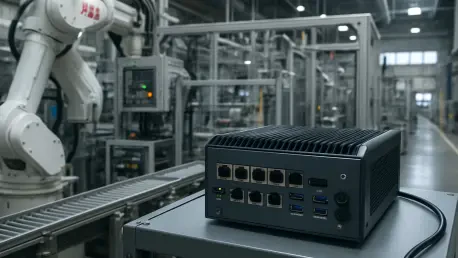In the heart of modern industrial landscapes, a transformative force is redefining how data drives decisions, with edge computing emerging as a pivotal technology in the era of digital transformation. Imagine a manufacturing plant where machines communicate instantly, analyzing data on the spot to prevent downtime before it even occurs, all without relying on distant cloud servers. This scenario is becoming a reality as industrial edge computing gains traction, enabling real-time processing at the source of data generation. By decentralizing computing power, industries such as manufacturing, energy, and transportation are witnessing unprecedented efficiency and responsiveness. This technology is not just a tool but a cornerstone of Industry 4.0, pushing the boundaries of what’s possible in operational agility and innovation. As the demand for low-latency solutions skyrockets alongside the proliferation of IoT devices, understanding the impact of edge computing on industrial sectors becomes essential for staying competitive in a rapidly evolving market.
Market Dynamics and Growth Trends
Driving Forces Behind Edge Adoption
The industrial edge computing market is experiencing robust growth, fueled by an insatiable need for low-latency data processing and the rapid expansion of Internet of Things (IoT) devices across industrial environments. This surge is fundamentally tied to the integration of Operational Technology (OT) with Information Technology (IT), allowing seamless data collection and analytics directly on the factory floor. Such integration slashes bandwidth usage by processing data locally, significantly enhancing security by minimizing data transmission risks. Furthermore, the ability to support critical applications that demand immediate responses is transforming how industries operate. From predictive maintenance to real-time quality control, edge solutions are empowering companies to make swift, informed decisions without the delays associated with centralized cloud systems. This shift is not merely technological but a strategic imperative for businesses aiming to maintain operational reliability while embracing the digital wave of Industry 4.0.
Regional Variations in Market Expansion
Geographically, the industrial edge computing landscape reveals striking disparities that highlight varying levels of technological readiness and industrial development. North America currently holds the lead, thanks to its advanced infrastructure and early adoption of cutting-edge technologies, positioning it as a hub for innovation in this space. Meanwhile, the Asia Pacific region is on a trajectory of rapid growth, driven by accelerated industrialization and widespread implementation of IoT solutions, bolstered by supportive government policies promoting smart manufacturing. This contrast underscores a broader global trend where adoption rates differ based on economic and technological contexts, yet the overarching movement toward edge computing remains consistent. As industries worldwide recognize the value of localized data processing, these regional dynamics illustrate both challenges and opportunities for market players aiming to expand their footprint in diverse industrial ecosystems.
Technological Innovations and Strategic Moves
Pioneering Solutions by Industry Leaders
At the forefront of industrial edge computing are key players like Amazon Web Services (AWS), Hewlett Packard Enterprise (HPE), and Dell Technologies, whose innovative offerings are setting new benchmarks for scalability and security. These companies are not just providing tools but are crafting comprehensive solutions that address the core needs of industrial sectors, from streamlined software deployment to actionable insights derived from edge data. Their focus on integrating IoT, artificial intelligence (AI), and edge computing technologies ensures that industries can handle vast data volumes without overburdening traditional IT systems. This approach is particularly vital in environments where every second counts, such as automated assembly lines or energy grid management. By prioritizing ease of use alongside robust security measures, these leaders are enabling a smoother transition to data-driven operations, fundamentally altering how industrial processes are managed and optimized in real time.
Investment and Collaboration as Growth Catalysts
Beyond product innovation, strategic investments in research and development are propelling the industrial edge market forward, with companies forming partnerships to stay ahead in a competitive landscape. Collaborative initiatives are proving essential, as they pool expertise and resources to tackle complex challenges like integrating centralized management systems with decentralized edge solutions. Such alliances ensure operational coherence, allowing industries to scale their edge computing capabilities without sacrificing efficiency or security. Moreover, the emphasis on continuous technological advancement reflects a market driven by the need to adapt to an ever-growing number of connected devices. As these strategic maneuvers unfold, they highlight a commitment to not only meeting current demands but also anticipating future needs, ensuring that industrial edge computing remains a dynamic and indispensable segment for modern operations across various sectors.
Reflecting on Transformative Impacts
Legacy of Real-Time Data Solutions
Looking back, industrial edge computing carved a significant path by prioritizing speed and localized data handling, fundamentally reshaping industrial operations over recent years. The ability to process information at the source reduced dependency on centralized IT infrastructure, fostering more autonomous and resilient systems that adapted swiftly to operational demands. This shift became a defining feature of Industry 4.0, where the fusion of physical assets with advanced analytics drove efficiency in ways previously unimaginable. Leaders like AWS, HPE, and Dell played pivotal roles, their innovations becoming benchmarks for what edge technology could achieve in enhancing security and responsiveness. The momentum built through these advancements underscored a global trend toward embracing edge solutions as essential tools, leaving a lasting imprint on how industries approached digital transformation and operational agility in diverse sectors like manufacturing and transportation.
Charting the Path Forward
As the legacy of industrial edge computing continues to influence industrial strategies, the focus now shifts to actionable steps for sustaining this momentum. Industries must prioritize investments in scalable edge solutions that can adapt to increasing data volumes and evolving IoT landscapes. Exploring partnerships with technology providers can offer access to cutting-edge tools and expertise, ensuring seamless integration with existing systems. Additionally, attention should be given to workforce training, equipping teams with the skills to manage and optimize edge technologies effectively. Policymakers in regions like Asia Pacific could further accelerate growth by crafting incentives for smart manufacturing adoption. By addressing these areas, industries can build on past successes, ensuring that edge computing remains a vital enabler of efficiency and innovation. This forward-looking approach promises to solidify the role of edge technology in navigating the complexities of modern industrial challenges.









